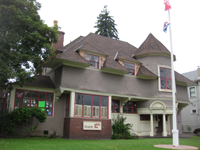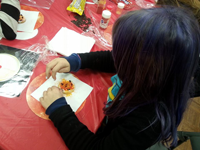Return to Five Stars home
Return to Five Stars Intergenerational Model

Girls Inc. of the Island City
Since its founding in 1964, Girls Inc. of the Island City (GIIC) has provided youth development services to over 300 girls annually in Alameda, California. These girls, ages 6-18, represent the broad diversity of families living in Alameda. GIIC offers research-based programs with curricula delivered by trained mentoring professionals in a positive all-girl environment. It endeavors to equip girls to broadly achieve academically and—through its Eureka! Program—to discover an interest in STEM. The Five Stars Program partnered with the Eureka! Program to provide hands-on achievement opportunities in STEM academics, college and career preparation, and personal development.
This case study focuses on the past year’s implementation effort of the Five Stars program. We began the year with a robust team of seven, consisting of the Girls Inc. Teen Program Director, a Eureka! Instructor, our program evaluator, the Five Stars Principal Investigator and co-Investigator and, finally, a UC Berkeley graduate and undergraduate student. It should be noted that we also received on-going support from the Girls Inc. Executive Director.
Members of our team met regularly to work on Five Stars weekly science session agendas to assure that everyone 1) understood the content, 2) felt confident about the hands-on activities and 3) understood their role in the session. We also created customized icebreakers for each of the sessions—this began each interaction with the teens on a sociable note and set the stage for the science topic of the day (plus, they were fun!)
Meeting regularly allowed us to reflect on our sessions, taking note of what went well and areas where we needed to put more attention. The topic that came up more than once in our reflection was that we were not allowing enough time to do all we had planned. We addressed this issue by creating a core activity and then one or two additional activities that could be done, should time allow. We were fortunate to have our evaluator’s feedback as well as info she had collected from our teens to incorporate into our discussions.

Making a solar cookie at the Five Stars Sun Fair at Girls Inc.
of the Island City.
Whenever we planned to use an activity that our UC Berkeley students had not done before, we set aside time to work our way through the activity, doing all the hands-on components. Our students mentioned that this level of preparation is a great way to reduce any nervousness they had about teaching. We found it gave them a realistic notion of timing of the activity and an advance sense of where there might be questions from the teens.
During our weekly sessions we also identified locations for potential field trips, identified goals for the trips and planned logistics. We were fortunate to have several visit-worthy local solar resources that had women in leadership positions. We ultimately visited Stanford University where we toured the campus, met with Dr. Aimee Norton, a solar physicist, who presented a talk on her career and current research, and we finished the day with a tour of the Wilcox Solar Observatory to get our hands on some very cool solar images. Our second field trip was to UC Berkeley. Here we visited CalSol, a student-run organization that designs and builds solar cars capable of racing at highway speeds. We were hosted by Aly Scheske, Operations Director and an engineering undergraduate student at UC. The interaction between the teens and the Cal students was very animated. We were also lucky to have Aly’s mother, an engineer herself, visiting CalSol, who provided another perspective on women working in STEM fields.
The three primary components of the program—weekly planning meeting, face-to-face sessions at the GIIG site, and field trips providing opportunities to see women working in STEM—made the GIIC experience a successful one for all generations of the Five Stars model.
Return to Five Stars home
Return to Five Stars Intergenerational Model